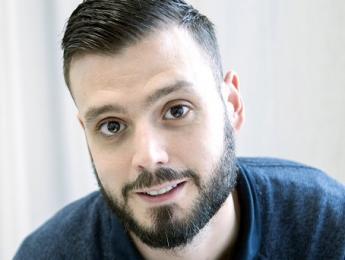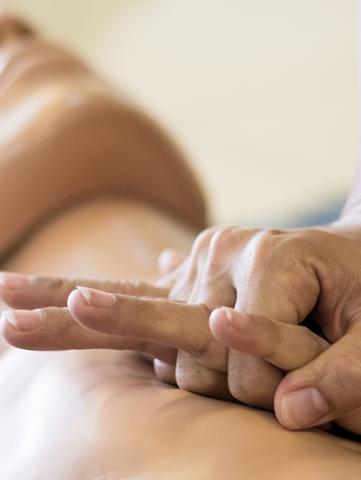
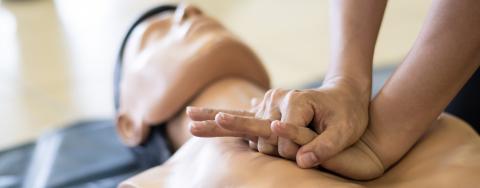
Immersion in the simulation department
"Never the first time on a patient", this is the first objective of the simulation department at Sorbonne University. This pioneering department in France is using this learning method for initial training, which has now become essential.
"Heart rate analysis in progress, shock recommended, stay away from patient". The robotic voice of the defibrillator announces the impending shock. Followed by hands in rhythmic motion, which continuously massage an inanimate torso. Two students take turns in front of their attentive classmates. We are on the fourth floor of 105 boulevard de hôpital in Paris, in one of the two simulation laboratories of the Sorbonne University Faculty of Medicine.
An education that is closer to reality
“A 52-year-old man has just suffered from a heart attack in a restaurant”. Margaux Dumont, an emergency physician at Pitié-Salpêtrière, chose this scenario to train her second-year cardiac arrest group. Alternating in the roles of waitress and emergency worker at Samu, the professor watches the students "resuscitate" the mannequin whose electronic device shows to the effectiveness of cardiac massage.
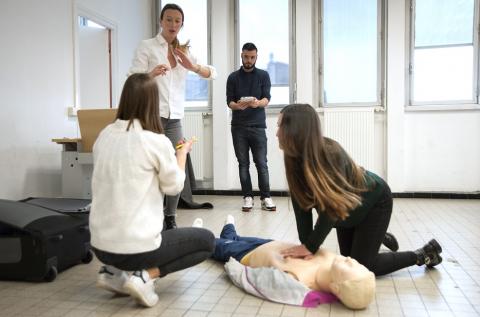
La formatrice urgentiste se glisse dans la peau d’une serveuse de restaurant pour cette séance de simulation sur l’arrêt cardiaque avec deux étudiantes de premier cycle.
"The first simulation that we developed in 2011 focused on cardiac arrest," explains Prof. Yonathan Freund, director of the simulation department and professor and hospital practitioner in the emergency department. “Professors develop their scenarios based on the educational resources available to us and the targeted educational objectives. For example, here the goals are to recognize cardiac arrest, massage properly, develop leadership, and call a resuscitator."
Behind the classroom where the students are gathered, we discover another medical room. A "high-fidelity" mannequin is bedridden. He may blink, sweat, have altered pupils, be intubated, or other symptoms. Around him, other models await the next simulation sessions: a pregnant woman, a newborn, and a severely traumatized patient. While it enables better immersion for participants, the realism of the mannequins comes at a price. “A high-fidelity model costs around 80,000 euros and a medium-fidelity model costs 15 to 20,000 euros,” says Yonathan Freund.
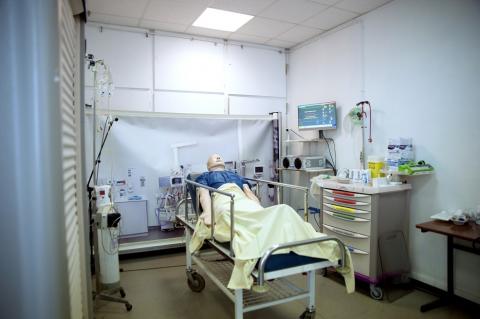
Pour veiller sur ces précieux cobayes, les étudiants ont à leur disposition des scopes affichant les constantes cardiaques et respiratoires, un charriot d'urgence, des défibrillateurs, du matériel pour faire des radios, intuber le malade, le perfuser.
Jérémy Leroy, teaching assistant in the simulation department, and the teachers (such as doctors, emergency physicians or surgeons) can follow the situation via an audiovisual broadcast, just like the students who do not participate directly in the simulation.
"Using a microphone, we can speak for the patient, phone the students during the simulation or enter the scenario to play the emergency senior or a member of the Samu," explains the assistant. Depending on the educational objectives and the actions of the students, we modify the parameters of the mannequin and cause other symptoms (such as breathing difficulty or cardiac arrest). At the same time, we can see all the gestures that the students make. We are attentive to every moment of communication, doubt, error and then review this with them during the debriefing”.
Each session lasts approximately one hour with a 10 to 30 minute scenario that must be didactic, plausible and realistic. The debriefing is the most important part of the workshop. It allows students to analyze situations, realize their mistakes and make progress thanks to the feedback from teachers.
A pioneering faculty in the use of simulation in training
"At Sorbonne University, we are pioneers, nationally, in the field of simulation used in initial training with a very large educational offer and volume of students," says Professor Freund. The Faculty of Medicine has been involved in the medical simulation activity since 2011. First set up by the resuscitation and emergency services team at Pitié-Salpêtrière to deal with life-threatening emergency situations, simulation has been developed in all specialties including: resuscitation, anesthesia, emergencies, exceptional health situations, pediatrics, neonatology, surgery, urology, radiology, gynecology, care relations, orthopedics and nursing care.
“The Faculty of Medicine has always given us a lot of supported,” says Yonathan Freund. Over the years, we have obtained premises and funding to invest and maintain the equipment. New medical practitioners have joined us for more workshops. And in 2021, we should have a new site entirely dedicated and adapted to simulation."

Yonathan Freund, directeur du département de simulation à la faculté de Médecine et PU-PH au service d’accueil des urgences.
Currently, the simulation laboratory is used to train the graduate student community and nursing and paramedical students. It concerns the externs of the faculty, but also the interns of hospitals attached to the University, as well as the students in continuing education. That is to say nearly 2000 people per year.
What are the benefits for students?
"To respect the patient and their safety, it is recommended to have already performed a medical procedure in a simulated situation", specifies Professor Freund. “And this is all the more important for sensitive, technically difficult gestures or for rare situations such as war wounds.” Today, each medical student spends twenty to thirty half days in the simulation department during their first six years of study. The educational objectives vary from one session to another: recognition of pathology, learning of technical gestures such as sutures, installation of a drain, urinary catheter, perfusion, intubation, cardiac massage, lumbar puncture, etc. Imaging simulation also allows students to understand the physiology of the body and to learn about ultrasound.
The other educational priority relates to the acquisition of soft skills. Simulation allows you to learn how to manage a crisis, communicate with the team, develop leadership and manage stress. Without forgetting the caretaking relationship though mock interviews (announcements of serious illness or prevention) to learn how to communicate with patients.
All of these educational objectives are part of a scientific approach. “Within the simulation department, we welcome a doctor who is doing a thesis in educational sciences on simulation pedagogy. With other researchers, we have published studies on how students feel, improving sessions and the impact of simulation learning on students' skills and quality of care,” explains Yonathan Freund. “Among these studies, we have shown that one or two simulation sessions is enough to restore the confidence of the students."
Jérémy Leroy, teaching assistant in medical simulation
Since January 2020, this former paramedic from the mobile emergency and resuscitation structure (SMUR) has been preparing simulation sessions, collaborating in writing scenarios, assisting trainers, setting up software and ensuring the maintenance of mannequins. “As an ambulance driver, I have been faced with life-threatening emergencies,” explains Jérémy Leroy. “As a first-aid trainer for eight years, I put this experience to the service of the community of teachers and students. Simulation, in my opinion, is the future of medical education. Today, you can't imagine a professional pilot flying an airplane without having trained on a simulator. The same is true in medicine. The goal is not only to put learners in a situation, but also to get them to do the right things and correct their mistakes in a positive and benevolent way.” In a few months, Jérémy Leroy will also be part of the team of "damage control" trainers.
